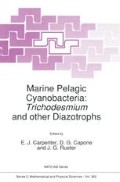Abstract
This study reviews data collected during Trichodesmium blooms in the Gulf of Thailand. The blooms appear to be harmless events, but under exceptional conditions, Trichodesmium are driven inshore by tides and winds and have caused extensive damage to farmed fish and shrimp. Blooms have been recently observed in wider areas than that observed during the last decade. Trichodesmium is a source of food for Zooplankton and plankton feeding fish. Relationships between Trichodesmium blooms and environmental data are examined and discussed.
Access this chapter
Tax calculation will be finalised at checkout
Purchases are for personal use only
Preview
Unable to display preview. Download preview PDF.
References
Adnan, Q. (1984) ‘Distribution of dinoglagellates at Jakerts Bay, Taman Jaya, Baten, and Benoa Bay, Bali: a report of an incedent of fish poisoning at eastern Nusa Tenggara’ in A.W. white, M. Anraku and K. Hooi (eds), Toxic Red Tides and Shellfish Toxicity in Southeast Asia, SEAFDEC IDRC, pp. 25-27.
Charernpol, S. (1957) ‘Preliminary study of discoloration of sea water in the Gulf of Thailand; IX Pacific Science Congress, pp. 1-8.
Devassy, V.P. (1989) ‘Red Tide Discoloration and its Impact on Fisheries’, in T. Okaichi, D. Anderson and T. Nemoto (eds), Red Tides Biology, Environmental Science and Toxicology, Elsevier, N.Y., pp. 57–60.
Lam, C.W.Y. (1984) ‘Red tide occurrence in Hong kong’, Hong kong Environmental Protection Agency Technical Memorandum, No 5/84.
Lursinsap, A. (1967)’ seasonal variations of food in the stomach contents of Rastrelliger neglectus (van Kampen) in the Gulf of Thailand’, M. Sc. Thesis, Faculty of Science, Chulalongkorn University, 97 pp.
Marumo R. (1973) ‘Phytoplankton in the sea area of the Southeast Asia’, Proc. 3rd CSK Symposium, Bangkok, pp. 221–259.
Suvapepun, S. (1982) ‘Red tide in the coastal water of the Gulf of Thailand’, Fisheries Gazette 35(6), 581–593.
Suvapepun, S., Chenbamroong, S. and Wangcharernporn, W. (1984) ‘Impact of red tide on coastal fisheries’, Proceeding of the 22nd Conference, Kasetsart University Bangkok, 15.
Author information
Authors and Affiliations
Editor information
Editors and Affiliations
Rights and permissions
Copyright information
© 1992 Springer Science+Business Media Dordrecht
About this chapter
Cite this chapter
Suvapepun, S. (1992). Trichodesmium Blooms in the Gulf of Thailand. In: Carpenter, E.J., Capone, D.G., Rueter, J.G. (eds) Marine Pelagic Cyanobacteria: Trichodesmium and other Diazotrophs. NATO ASI Series, vol 362. Springer, Dordrecht. https://doi.org/10.1007/978-94-015-7977-3_23
Download citation
DOI: https://doi.org/10.1007/978-94-015-7977-3_23
Publisher Name: Springer, Dordrecht
Print ISBN: 978-90-481-4126-5
Online ISBN: 978-94-015-7977-3
eBook Packages: Springer Book Archive

